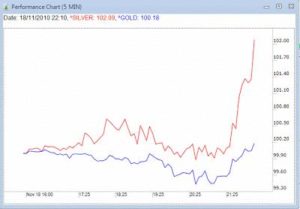Here is a chart that shows comparison of Silver and Gold today evening. This is 5 minute but look how Silver is outperforming.

The message is: strong trends can persist for a long time. Always go with the flow.
Light Reading
Irish Stew
In Ireland, banks are feeling the pressure of withdrawals. Financial Times reports that Irish bank customers have withdrawn an estimated 11% of deposits over just a few weeks. The Irish banks are now relying heavily on the ECB for liquidity.
WSJ.com says “Markets are finally betting on a bailout for Ireland.”. This means that the Irish debt problem will be sorted out in some way or the other. It could certainly mean a lot of pain to Irish citizens, maybe, some pain for European banks who have Irish loans. My sympathy goes to the citizens who are now paying for the follies of the banks. Pity. But, at least we have a sense that the world is not coming to an end. Therefore, a market decline based on Ireland may not be justified.
All Time Highs
247wallst.com tell us about some commodities and services which have hit all time highs. Here is a list:
Gold
Tution Fees
Shipping (Transportation of goods)
Cotton
Prescription Drugs
Checking Accounts (cost of using a bank current account)
GM IPO
Shares of GM (General Motors) are selling at 35.44, up almost 7% from the IPO price of 33 dollars.
Morgan Stanley: Here’s Why Half The World Suffers Food Price Inflation While America Doesn’t
A key reason why commodity price volatility is such a threat in much of the world, while being far less of a threat in the U.S., is that Americans eat food whose cost of production is far less exposed to agricultural prices.
For example, the price of peanuts is just a small fraction of the price of a jar of branded peanut butter. Thus when peanut prices rise 10%, the cost to produce a jar of peanut butter doesn’t rise nearly as much. Yet in nations where people eat less processed and branded food, buying meats and vegetables from a fresh market for example, then a 10% surge in commodity prices is far more painful for consumers.
This and other factors leads Morgan Stanley to believe that commodity surges we’ve seen so far won’t cause high inflation in the U.S.:
(http://www.businessinsider.com/)

